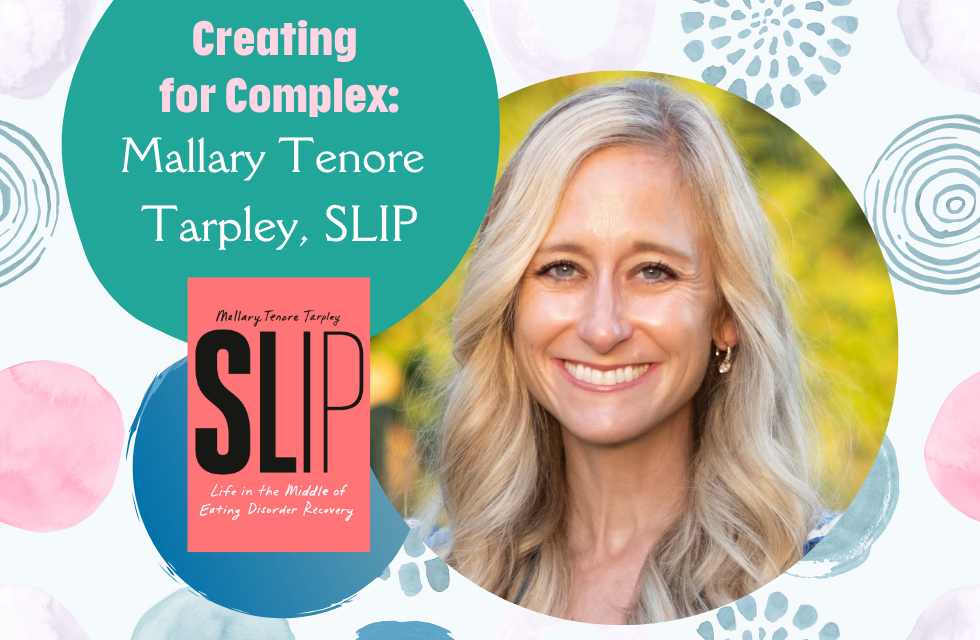
(This is the second profile in “Creating for Complex”, a series on my blog highlighting people creating meaningful solutions to issues faced by the complex medical needs community. Please note: Bookshop.org affiliate links are used in this post.)
Like many 80’s/90’s kids, I first learned about eating disorders from a “very special episode” of the sitcom Full House. In the show, teen DJ Tanner wants to lose weight for a pool party, so she starts working out nonstop and starving herself. By the end of the half-hour episode, the family has held an intervention for DJ and she “miraculously” recovers, learning to love her body just the way it is. Disordered eating, body image, and related topics are never mentioned again.
In the real world, eating disorders rarely have a clear-cut ending. Progress is not linear, nor is recovery clearly defined.
In her new book SLIP: Life in the Middle of Eating-Disorder Recovery, journalist and professor Mallary Tenore Tarpley examines this uncertain in-between space. Her book is part narrative, part investigative report into the realities of living with eating disorders.
Mallary’s disordered eating began at age 12, shortly after her mother died of cancer. Mallary was hospitalized and in residential treatment centers in the greater Boston area throughout much of middle and high school. She would go on to graduate from college and earn her master’s degree. Today, she is a journalist and professor, living in Texas with her husband and their two children. She continues to consider herself “in recovery” rather than “recovered”.
I’ve known Mallary since my freshman year of college. I was honored to speak with her recently about SLIP, and how it relates to caregiving, the medically complex community, and more.
Inhabiting our past without invading our present
One thing I appreciate about Mallary’s book is how she approaches sharing stories with privacy, compassion and dignity.
In one particularly moving scene in the book, Mallary returns to Boston Children’s Hospital as an adult. She realizes she will not be able to revisit the particular hospital wing where she had stayed as a child, but that this might be for the best. She calls this moment “a reminder that some parts of our life can inhabit our past without needing to invade our present,” (page 83).
I mentioned to Mallary that this passage spoke to me as a parent dealing with medical trauma from my son’s early years. I asked how she was able to separate her present self from those hardest times – like her inpatient stays – while writing this book.
“There are memories we want to hold space for, but we don’t want them to define us,” Mallary said. “I find that there are moments where I need to write to process, but I write for an audience of one. Then, I can go back and decide what I feel safe to share.”
In addition, Mallary shared that with a topic like eating disorders, certain details can quickly shift from cautionary or informative to prescriptive or “how to”, rather than cautionary.
“I don’t want parts of my past invading my present or others’ present. I was careful to show the negative repercussions when sharing painful details. I don’t want to invade others’ privacy or in any way interfere with their recovery process,” Mallary told me.
Mallary’s father plays a large role in her story, as he was her primary caregiver for most of her younger years. I know that she remains very close with him, so I wanted to know how she approached writing about him in her book. She told me that she frequently reached out to her dad throughout the writing process.
“I wanted my father to have not only a voice, but also a say in the book, writing with him and not about him,” she said. “Once you put out a book, it is no longer just your story. It’s many people’s stories.”
Caregiving and the importance of sharing stories
I asked Mallary how she feels now that her book is out in the world
“It has been incredibly gratifying seeing how my own vulnerability has convinced others to share their vulnerability. I am recognizing that in a lot of ways I’ve done what I have always wanted – to help others feel less alone.”
One thing that has surprised her during her book tour is how being an author is like being a caregiver, particularly to readers she meets who are dealing with their own (or loved ones’) eating disorders.
“I’m a nurturer, and as someone who wants to help people, I needed to learn how to set up boundaries and point people to other resources,” Mallary explained. “As you know, we begin losing our sense of self if only helping others. We get depleted. I need to hold space and energy to care for myself and my children.”
Setting an example for our children
Here are Mallary’s suggestions for parent resources and children’s books to promote positive body image at home:
Substack recommendations for grownups:
• Oona Hanson, Parenting Without Diet Culture
• Virginia Sole Smith, Burnt Toast
Book recommendations by age:
• For young children: Vashti Harrison, Big
• For middle readers: Lisa Fipps, Starfish
• For middle/YA readers: Charlotte Markey, The Body Image Book for Girls
• For middle/YA readers: Charlotte Markey, Daniel Hart and Douglas Zacher, The Body Image Book for Boys (Mallary has not read this book yet, but we wanted to make readers aware it is also available.
• For parents: Virginia Sole-Smith, Fat Talk: Parenting in the Age of Diet Culture
Recent posts 
Creating for Complex: Mallary Tenore Tarpley and SLIP

Wheelchair Halloween costume ideas
